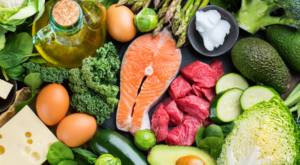
What are the Most Effective Ways to Lose Weight in a Month?

Losing weight is a typical goal for many people, and where a few also desire to lose significant weight in a month. While it may appear to be a difficult task at first, it is possible to lose weight in a month if the proper strategy is followed.
Table of Contents
Introduction
This comprehensive article attempts to give you useful information on how to lose weight in a month by combining exercise, lifestyle changes, and the best diet to lose weight in a month. You will be prepared with the knowledge and methods needed for a safe and sustained weight loss journey if you follow the directions and advice mentioned here.

How to Lose Weight in a Month
You can make your weight loss journey successful by following certain strategies. Here are the best tips to lose weight in a month:
Begin by Setting Achievable Goals

The first and most important step to losing weight in a month is to set realistic goals. Approaching this process with a balanced viewpoint is critical since losing weight too quickly can be both unrealistic and potentially damaging to your overall well being. A safe and healthy weight reduction pace is commonly regarded as 1-2 pounds per week. This amounts to a total weight loss of 4–8 pounds over a month. Setting attainable goals can help you avoid unneeded disappointment and guarantee that your weight loss journey is long-term.
Make a Calorie Deficiency
A calorie deficit is the foundation of any successful weight loss program. This idea offers an effective way to lose weight in a month and relies on ingesting fewer calories than you burn each day. A calorie deficit of around 3,500 calories is required to lose one pound of fat. This gap can be met by a combination of the best diet to lose weight in a month and consistent physical activities.
Consume a Low Calorie Diet

A low-calorie diet is a weight loss strategy in which you consume fewer calories than your body requires to maintain its present weight. This diet works based on creating a calorie deficit, pushing your body to burn stored fat for energy. A low-calorie diet typically consists of consuming 1,200–1,500 calories per day, depending on individual needs and goals. Because it restricts total energy consumption, this method can be a very effective way to lose weight in a month.
However, it is crucial to recognize that substantially lowering calorie consumption may have unintended consequences. Calorie restriction can result in dietary shortages, lower energy, and an increased risk of muscle loss. It is critical to maintain a balanced diet that offers important nutrients while minimizing overall calorie intake.
Try the Low Carb Diet

A low-carb diet restricts carbohydrate intake while increasing protein and fat consumption. This method attempts to put the body into a state of ketosis, in which it burns fat for fuel rather than carbohydrates. Carbohydrate restriction keeps insulin levels low, and the body uses stored fat for energy.
A low-carb diet often involves restricting carbohydrate intake to 20–100 grams per day, depending on the diet plan. Grains, starchy veggies, and sugary items are prohibited, whereas non-starchy vegetables, lean meats, and healthy fats are encouraged.
Low-carb diets have been demonstrated to be one of the best diets to lose weight in a month by reducing hunger, improving blood sugar regulation, and increasing fat burning. To guarantee a balanced intake of key nutrients, choose nutrient-dense carbs and focus on eating a range of foods.
Practice Intermittent Fasting

Intermittent fasting is an eating habit that alternates between fasting and eating intervals. There are numerous techniques for intermittent fasting, such as the 16/8 strategy, which involves fasting for 16 hours and restricting meals to an 8-hour window each day. Another common strategy is the 5:2 diet, in which you eat normally five days a week and limit your calorie intake to 500–600 calories on the other two days.
Intermittent fasting can help you lose weight by lowering your overall calorie intake and improving insulin sensitivity and fat burning. Furthermore, some research suggests that intermittent fasting may offer additional health benefits, such as improved cognitive function and longer longevity. It is crucial to note, however, that intermittent fasting may not be the easiest way to lose weight in a month for everyone, especially those with specific medical issues or a history of disordered eating.
Try VLCD (Very Low Calorie Diet)
A very low-calorie diet (VLCD) is a more extreme form of calorie restriction that typically involves eating less than 800 calories per day. VLCDs may include meal replacement shakes, bars, or soups that are nutritionally designed to deliver critical nutrients while limiting calorie consumption.
VLCDs can result in rapid weight loss, which might be advantageous for people who need to reduce weight quickly for health reasons. Due to their inherent hazards, these diets should only be followed under medical supervision. Nutrient shortages, gallstone development, electrolyte imbalances, and decreased metabolism can all be caused by VLCDs. They are often advised for short-term use as part of a complete weight loss program that includes continuing support and lifestyle adjustments.
Perform Cardio Exercises

Cardiovascular exercise, often known as aerobic exercise, is any type of physical activity that raises your heart rate and breathing rate. Jogging, cycling, swimming, and brisk walking are examples of such activities. Cardio activity is a great strategy to burn calories and lose weight. It raises your heart rate, resulting in higher calorie expenditure during and after your workout.
Regular aerobic exercise can help improve cardiovascular health, stamina, and overall fitness levels. However, while aerobic activity is useful for weight loss, it should be paired with the best diet to lose weight in a month and strength training for the best outcomes. As advised by health organizations, aim for at least 150 minutes of moderate-intensity aerobic activity or 75 minutes of vigorous-intensity aerobic activity every week.
Exercise with HIIT (High-Intensity Interval Training)
HIIT is a type of exercise that consists of short bursts of intense exercise followed by rest or low-intensity exercise. Because of its potential to enhance calorie burn and raise metabolism, this form of activity is recognized as quite an effective way to lose weight in a month. HIIT workouts can be adjusted to a variety of exercises, including running, cycling, and bodyweight exercises.
The intensity of HIIT causes the body to burn more calories during and after the workout, a phenomenon known as the “afterburn effect” or excess post-exercise oxygen consumption (EPOC). This means that your body continues to burn calories even after you end your workout.
Because HIIT sessions are often shorter than regular cardio workouts, they are a time-efficient choice for those with hectic schedules. However, because HIIT workouts are tough, they may not be appropriate for everyone. To avoid injury, it is critical to begin slowly and listen to your body.
Use Supplements for Weight loss

Weight loss supplements are products that promise to help people lose weight by improving metabolism, lowering hunger, or decreasing fat absorption. These supplements can take the form of tablets, powders, or liquids and often contain a combination of herbs, vitamins, minerals, or other components.
While certain weight reduction products may provide short-term benefits or help with appetite control, they should be used with caution. Many weight-reduction products lack scientific proof to back up their claims, and their safety and efficacy can vary. Before using any weight-reduction supplements, contact a healthcare expert to confirm they are safe for your specific circumstances and to avoid potential problems with drugs or underlying health conditions.
Note: There might be affiliate links mentioned here. We may receive a commission if you purchase a product through an affiliate link. There is no additional charge for you. Please do your own research before making any online purchases.
Consider Non-Surgical Weight Loss Options
Non-surgical weight loss techniques are medical interventions that help people lose weight without requiring invasive surgery. Individuals with a body mass index (BMI) above a specific level or those who have not been successful with other weight loss approaches are often advised to undergo these procedures.
Non-surgical weight loss procedures include gastric balloon insertion, which involves inserting a temporary balloon into the stomach to reduce its capacity, and gastric endoscopic therapies, which use endoscopes to reduce stomach size or restrict nutrient absorption.
These procedures can help people lose weight, but they are usually only indicated for people who fit certain criteria and have been reviewed by medical professionals. To find out if non-surgical weight loss techniques are right for you, speak with a healthcare physician who specializes in weight management.
Individuals may also use non-surgical fat reduction procedures to target specific areas of resistant fat.
Non-surgical fat reduction procedures are available, and each works slightly differently to remove fat cells. Non-surgical fat reduction therapies that are regularly employed include:
- Cryolipolysis (Cool Sculpting): Cryolipolysis is a non-invasive fat reduction method that involves freezing and destroying fat cells with controlled cooling. The process involves applying a specific device to the targeted location, which cools the fat cells to a temperature that causes them to die naturally. The body normally removes these dead fat cells over time, resulting in fat reduction in the treated area. Cryolipolysis is commonly used to target problem regions such as the abdomen, thighs, flanks, and double chin.
- Radiofrequency (RF) Treatments: Radiofrequency treatments heat the skin and underlying fat layers, causing fat cells to break down. The heat increases collagen formation, which might result in skin tightening as well as fat loss. RF treatments are frequently utilized to target specific areas such as the abdomen, arms, thighs, and buttocks.
- High-Intensity Focused Ultrasound (HIFU): HIFU technology targets and destroys fat cells beneath the skin’s surface by using focused ultrasound pulses. High-intensity ultrasound energy warms and disturbs fat cells, causing them to break down. HIFU is often used to remove fat from the abdomen, flanks, and thighs.
- Laser Lipolysis: Also known as laser-assisted liposuction or laser liposuction, laser lipolysis employs laser energy to liquefy fat cells, making them easier to remove through a small incision. This method is less intrusive than regular liposuction and can be done with a local anesthetic. Laser lipolysis is frequently used to treat tiny areas such as the chin, neck, arms, and knees.
- Injectable Fat Reduction: Injectable fat reduction treatments involve the administration of drugs or substances that can aid in the dissolution or shrinkage of fat cells. These treatments are often utilized in smaller locations and are frequently used in conjunction with other cosmetic procedures. Injections of deoxycholic acid, a chemical that breaks down fat cells, are one example of how submental fat (double chin) might be reduced.
It is vital to remember that non-surgical fat reduction therapies are not weight loss solutions but rather procedures for reducing resistant fat in specific locations. Individuals who are near their target body weight and have high skin elasticity are most suited for these procedures. Non-surgical fat reduction procedures produce variable results, and numerous sessions may be required to attain the desired result.
While non-surgical fat reduction therapies are usually thought to be safe, they may have side effects and hazards. Temporary redness, swelling, bruising, and numbness in the treated area are common adverse effects. Burns, scars, or changes in skin pigmentation are examples of serious consequences. It’s critical to speak with a trained and experienced healthcare expert or aesthetic specialist to decide if you’re a good candidate for non-surgical fat reduction and to go over the risks and advantages.
Stress Management
Stress management is sometimes underestimated, although it is critical for weight loss. High stress levels can contribute to overeating and weight gain, making effective stress-reduction measures essential. Meditation, yoga, and deep breathing techniques can all help with stress management. Adequate sleep is also necessary for stress management and weight control. It may seem like one of the easiest ways to lose weight in a month, but it is very crucial. To improve your general well-being, aim for at least seven hours of quality sleep per night.
Monitor Your Progress
Tracking your progress while you lose weight is a fantastic way to stay motivated and on track. Weighing yourself on a regular basis, keeping a food diary to measure your calorie consumption, and tracking your physical activity will help you detect patterns and make the required modifications. However, it is critical not to become unduly focused on the figures. Instead, concentrate on your overall improvement and how you feel both physically and psychologically.
Seek Assistance
Having a support system in place can considerably help you lose weight. Consider joining a weight loss program, such as Weight Watchers or Jenny Craig, where you can benefit from professional counseling and the company of others with similar aims. Seeking help on how to lose weight in a month from a friend or family member who can offer encouragement and accountability can also be quite beneficial. Online weight reduction communities and forums can provide extra sources of support, inspiration, and knowledge sharing.
Keep Yourself Hydrated
Staying hydrated is critical for weight loss and overall health. It can be considered one of the easiest ways to lose weight in a month, but it requires persistence. Drinking plenty of water can aid in the removal of toxins, the reduction of bloating, and the promotion of sensations of fullness. Aim for at least eight glasses of water every day, and adapt this amount according to your own needs and activity levels.
Be Persistent and Patient
It is essential that you follow your weight-loss procedure with patience and perseverance. It is possible to lose weight in a month, but it takes attention and effort. It is critical not to be disheartened by setbacks or delayed progress. Instead, concentrate on establishing long-term adjustments that you can maintain with the best tips to lose weight in a month. Remember that losing weight is a journey, and the ultimate objective should be to achieve optimal health and well-being rather than focusing exclusively on the numbers on the scale.
FAQs
Is it possible to shed pounds in a month?
Yes, with the appropriate approach and tactics, it is feasible to lose weight in a month.
How much weight should I expect to lose in a month?
A safe and healthy weight loss objective is 4-8 pounds per week or roughly 1-2 pounds.
What exactly is a calorie deficit, and why is it so important?
A calorie deficit occurs when you consume fewer calories than you burn, which is essential for weight loss.
What exactly is a low-calorie diet, and how does it aid in weight loss?
A low-calorie diet requires you to consume fewer calories than your body requires, forcing it to burn stored fat for energy.
What exactly is a low-carb diet, and how does it help with weight loss?
A low-carb diet limits carbohydrate intake, which promotes fat burning and reduces appetite.
What is intermittent fasting, and how does it aid to weight loss?
Intermittent fasting is an eating pattern in which periods of fasting and eating alternate, which can help reduce overall calorie intake.
Do weight loss supplements work?
Weight loss supplements may be beneficial in the short term, but their safety and efficacy vary. Before using them, consult a healthcare professional.
Is it safe to lose weight without surgery?
Non-surgical weight loss techniques are safe when used under medical supervision and are recommended for people who meet certain criteria.
How important is stress management in the weight loss process?
Stress management is essential for weight loss because excessive stress can lead to overeating and weight gain.
Is it necessary to track weight loss progress?
Tracking progress can help with motivation and making necessary changes to achieve weight loss goals.
Conclusion
In conclusion, reducing weight in a month is a goal that may be achieved with the appropriate mindset and technique. You can achieve your weight loss goals in a safe and sustainable manner by incorporating the best diet to lose weight in a month, cardio exercise, HIIT workouts, weight loss supplements, non-surgical weight reduction procedures, stress management techniques, progress tracking, seeking support, and maintaining patience and persistence. Setting reasonable goals, creating a calorie deficit, and prioritizing overall growth and well-being over numbers alone are all vital.
However, before beginning any weight loss program, it is critical to check with a healthcare practitioner, especially if you have underlying health concerns. They can assist you in developing a personalized plan that is geared to your individual needs and goals. Furthermore, it is critical to recognize that weight loss is not the only predictor of health. The key to achieving overall vitality and improving your quality of life is to focus on holistic well-being, which includes factors such as sleep quality, hydration, and mental health.
Disclaimer: The information provided in this article is for educational purposes only and should not be considered as a substitute for medical advice. Consult a healthcare professional before implementing any home remedies or making significant changes to your lifestyle.






